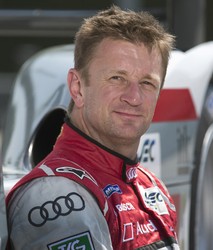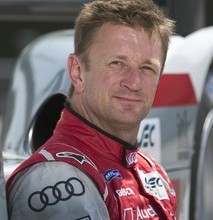Ask a pro
Receive advice directly from today’s top stars


Allan McNish
Three-time Le Mans winner and WEC champion
Three-time Le Mans 24 Hours winner and ex-Toyota F1 driver Allan McNish is the latest online driving instructor for SAFEisFAST.com.
During a career spanning 24 years, McNish raced for Audi, Porsche, and Toyota across a series of disciplines including Formula One, sports car racing and touring cars. By the time he hung up his helmet in 2013, the Scot had taken three overall wins at Le Mans, five Sebring 12 Hours victories, racked up 17 starts in Formula One and clinched the 2013 FIA World Endurance Championship.
Allan McNish answers your questions!
-
Alex Cascatau
Hello Allan! My question is: how do you correctly judge when you are fast through a corner/lap or not? Without any help of a digital dash or +/- delta times of course. Sometimes when I find myself in a kart/car and take a corner at the limit, I expect it to be way faster because of the line I take, braking point, power application etc, but it turns out I am not. So how do you correctly judge that, and how can you train this perception ability?




Hi Alex, it’s always difficult to work out when you’re on the limit because it’s subjective and depends on what your experience is. You know this when you go into a qualifying lap and ultimately you end up quicker – you’ve gone into the corner faster and hit the apex quicker and it’s like a voyage into the unknown. For me, it doesn’t start by braking later in these situations; instead it tends to be by carrying more speed through the apex. You can only really get on to the throttle at any given point and where that limit is can be found with the feedback from the car. So when the front or the rear of the kart or the car is sliding, when it isn’t holding to the absolute correct line, that’s when you’re on the limit. When you’re underneath the limit though, whether you’re at 80%, 90% or 97%, it’s a difficult thing to do, but you’ve got to go to 105%, which usually means spinning off before you realise you’ve gone too far. The point there is to understand when you’re close to the limit but without going to 105% in future. A suggestion though: if you’ve got a corner on the circuit where there is a lot of run-off area, and there’s limited risk of doing any damage, that’s where you try it, and not in a high-speed corner where the consequences are that if you spin, you’re going to have a crash. Try somewhere with limited risk and then you’ll build up your experience that way.
SAFEisFAST videos: The Fast Line Late Braking Hitting the Apex Braking
-
Tony
How do endurance teams determine the pace that they are going to run?




They don’t – they drive flat out. Simple. As a driver, you don’t drive to a lap time, you drive to the speed that you can go, because ultimately the competition level is too high. We do drive to an energy target in LMP1, but that is dictated by regulations, and you don’t have anymore energy than is allowed., so you’ve got to make sure you get to that energy target through the course of the lap. But lap time is done purely on how fast you can drive.
-
Christian Steele
What is your advice to drivers that desire financial support from outside of the family, to get into racing?




It’s very difficult to answer ‘how do you get financial support, because ultimately unless you’ve got a very, very rich family, and they really want to spend it on you, then it’s going to be a difficult situation. The only thing I can say is that if the people at the top are interested in motorsport, whether it be the head of the marketing department or CEO, then you’ve got a chance, but it’s a really tough sell. It’s a bit of a game in that respect.
The other thing is that if you go to them and say ‘I need money because I want to do my hobby’, then it is a charity, not a business. It’s got to be a business proposition because the amount of money that you’re requiring to have a good career means that they’ve got to get a return on investment, so you’ve got to go into every situation having a plan of what you can offer them, and what problems the deal solves for them. Maybe then you’ve got a chance. Finally, just like my father used to say, it’s a numbers game. If you approach one company, you’ve got a limited chance. If you approach a hundred companies, you’ve got a bigger chance of one of them being interested. But perceiver, keep fighting, keep working, and always think of it from their point of view, and not yours.
SAFEisFAST videos: Sponsorship Overview Sponsorship: Where to Begin
-
Keith Garcia
I’m a 16-year-old racing fan and want to make a career out of racing. What steps should I take to get started racing?




If you want to make a career out of racing, I personally think you should start out racing as a hobby. You’ve got to enjoy it. It’s a very difficult career – there’s easier ways to make a living than as a racing driver, but there’s also the sport that you can get involved with, whether it be in engineering, marketing, running a team… but whatever it may be, you’ve got to enjoy it. It’s got to be a hobby that is driven by passion and ambition instead of viewing it as a lifelong career., because the hours are hard, the life is difficult, it’s lots of time on the road filled with as much disappointment as it is happiness, as in you often loose more than you win, so it’s got to have that heartbeat of adrenaline that ruins through your veins first of all. The fact is though that you’re 16 years old, you’re a racing fan and you want to get involved, and that is a fantastic thing. If you want to get involved as a driver, try karting.
SAFEisFAST video: Getting Started
-
Violet
For a novice track day attendee who is still trying to figure out heel and toe, what is your advice when approaching a corner? Do you brake, downshift and maintain speed while cornering, or downshift then brake? Thank you so much!




Heel & toe… Oh dear! Not my area of expertise if I’m honest with you. I’ll tell you this between you and I, but no one else must know. I didn’t learn to heel and toe until I had raced in Formula Ford, Opel Lotus, Formula 3, and it was due to my first ever Formula One test that I damaged the dog rings in the McLaren-Honda in 1989, and then I had to learn to do heel and toe before F3000 the following year. Basically I’d been driving an F1 car by hitting the brakes, putting the clutch down and crashing it through, which wasn’t very sensitive. I learnt to do it in a street car eventually.
What you’ve got to do, whether you heel or toe or not, whether it’s a paddle shift gearbox – whatever it is irrelevant – the fact is that it’s all to do with the dynamics of the car and how you load the tyres. You never want to have too many things going on with downshifts etc when you’re turning, because you want to have as much of that done when you’re straight-ahead braking. If you’re turning, you have to release brake pressure to take load off the front, so that when there is destabilisation or change of speed it doesn’t upset the rear wheels. The first thing the car knows is me hitting the brake pedal and my downshift; I use my downshift points in every car I drive to judge the speed and also to change the dynamic of the car going in to a corner, whether I’ve got to push or whether the rear is loose. If the rear is loose, I’m going to downshift at a lower speed because I don’t want to make the car do too many things at once, whereas if I’ve got to push then I’ll maybe downshift quite quickly to unsettle the rear of the car so it can help me. But that’s all experience. The first thing you learn to do is brake in a straight line, and get most of your work done before you release the pedal to allow the car to float in to the corner. It’s not an aggressive action, it’s a gentle action.
SAFEisFAST videos: Braking Late Braking
-
Jon Illingworth
Going into the Le Mans 24 Hours this year, who do you think has the strongest package out of Audi, Porsche and Toyota?




We’ve all got different packages, we’ve all got strengths and we’ve all got weaknesses. I think Porsche are the ones who have the most experience of their current package because it’s very similar to last year. The Toyota and Audi cars are very new because of the hybrid systems, and Toyota with the engine as well. The endurance tests have brought up some areas to work on for everybody and we’ll only find out who’s strongest when we get into the race. It’s going to be a good one with three manufacturers going for it, and it’s going to produce some fun.
-
Matty Hart
Do you regret racing in Formula One for only one season? Looking back do you think you deserved another season racing with Toyota or Renault?




I think when I was testing with McLaren and Benetton in the early ‘90s, that was the time to make the jump but there wasn’t any opportunities at that point. When I did race with Toyota it was certainly not at the height of my career, that’s for sure. Renault never had the opportunity because they had two drivers who were signed up on multi-year contracts. That’s the reason I actually decided to come back to Audi, because I’m a racing driver and I wanted to race – I didn’t want to test. With Toyota, it’s always their prerogative to do what they want to do, but I think the results suggested that it wasn’t necessarily down to the drivers.
-
Joshua Gibson
Hi Allan, is it more physically draining or mentally draining to race in the Le Mans 24 Hours? Do you have to train more for that race than any other? Thanks.




It’s more mentally draining than physically to drive Le Mans. The long straights give you time to take a breath and to deal with any cramp in your left leg caused by the braking forces. But mentally when you’re driving for three and a half hours at one time without any mental rest and you’re on the edge of your seat, that’s when it’s tough. Emotionally it’s the biggest sports car race in the world, so when you’ve got a chance to win it then that’s a big thing as well. I didn’t train for it any more than any other race because a lot our training is actually with endurance tests, and that’s what prepares you better than anything else.
SAFEisFAST video: The Mental Edge
-
Khuram
Question: Do you think a Monaco GP replica go-kart track would be fun for fans to experience similar thrills to real F1 drivers?




Yes I do actually, because ultimately Monaco was designed for a time when cars were much slower, and now cars have outgrown the circuit. I think it would be a really good kart circuit with lots of overtaking opportunities. Sending one down the inside into the chicane… Can you imagine that? Or into Saint Devote, or Mirabeau…
-
Karthik
Hi Allan, when trying to extract the ultimate lap time from a car, how can you be sure if the last tenths or hundreds lie with the driver or the car setup?




Taking a step back is often the way to go. If you’ve reached a plateau and you can’t seem to take any more out of the car, it tends to be a matter of taking a step back. Don’t necessarily charge into the corner quicker; if you’re working hard on the steering wheel and fighting all the time then you’re always over and under the edge of limit and grip, and that seems fast, but ultimately it puts extra energy into the tyre and the tyre is your source of grip. Take a breath, take a step back, and go again.
SAFEisFAST video: The Perfect Lap
-
Daniel Lo
Hi Allan I am a big fan of yours! Through out your career you have competed in many categories. How do you adapt to different vehicles In terms of driving technique such as GT3, F3 and LMP1? And if I may ask how can one improve their pace once they reach a bottleneck? Thanks!!




Adapting to the car is the same as adapting to a circuit. As you’re going through your categories of racing or driving between categories, you’ve got to understand what the car or circuit wants and you’ve got to adapt your style to that. To an extent you need to adapt the car to you too, but when the race starts you’ve got to adapt to what changes, and that’s the car and the track evolution, so there’s always an adaption. Some drivers and their driving styles are better suited to single seaters and high downforce/power, and some are better tuned to momentum and lower downforce. Personally I always preferred higher downforce and higher power – the more performance the car had, the better I went.
SAFEisFAST video: Driving with Downforce
-
Marcell Szilagyi
Do you think, that Audi can really win Le Mans with only the speed of the car? Or do they need to get an advantage on Porsche’s unreliability? Because as far as I know Audi has a 5,3 MJ/lap (fuel energy + recovered energy) disadvantage to Porsche.




I think we’re very close in performance. It’ll be very close between us and Porsche, but he truth will be found out only when we get to qualifying. Reliability is always a factor, Marcell, it doesn’t matter what it is. The regulations are what they are, we can’t control them and we live with hem the best we can. One advantage is the ability for the petrol engine cars to do one lap longer on a tank than what we can with diesel, and that means that they’ve got a strategic advantage over the course of the race because they’ll do less pit stops.
-
Mark Legg
Has your race nutrition changed over the past few years, if so what changes have you made and how did it affect your performance?




Hi Mark, yes my race nutrition has changed compared to when I was a young kid. First of all you had no dietician, and second of all the food at the track was basically burgers, which certainly wasn’t the healthiest, but then again I was only racing for 20 minutes each time back then. Now we’ve got dieticians and doctors that make sure you eat the appropriate foods. Now I’m retired I’ve got to take more care because I don’t have that nervous energy that burns away the calories. One thing I do always have is a bar of chocolate somewhere. I did when I was racing too but we don’t tell anyone… Nutrition definitely affected my performance though, no question. The energy, fuel… If you put petrol in a diesel car or visa versa, it doesn’t work, and you’ve got to put the right energy in your body for sport too.
SAFEisFAST video: Nutrition: Fuelling the Driver
-
Andrew Dryburgh
Hi Allan. What are your thoughts on the new track section at Indianapolis and Arnage at Le Mans from a driver’s perspective please?




The new section of track at Indianapolis and Arnage hasn’t changed the track itself, it’s just opened it up a little bit. That’s changed since I first came to Le Mans anyway; when I first visited there was about a metre of run-off area into Indy. If you went wide even slightly you hit the barrier, but then they moved the barrier away and it meant you could attack more into it because you’ve got more margin for error. It’s probably done a little bit more of the same this time around, but the track itself is unchanged.
-
Damon
Hi Allan. Do you see a time where WEC will achieve a global profile similar to F1? In your view, what does WEC need to do in order to attract a greater following?




Not at the moment, because Formula One has been around for so many years, while WEC has only been around for a handful of years to build up a profile. It’s not fighting Formula One, though. It’s a different part of the sport and has a different philosophy, and it’ll take some time to fully develop. But where it has gone in the last five years has been very impressive.
-
Alan Mitchell
Hello, when faced with a new circuit, what steps would you take, if any, to learn the circuit and its idiosyncrasies and how long would it take before you had found the limit of your ability and that of the vehicle you are driving? Thank you.




When faced with a new circuit, I used to walk the track. I’d look at the kerbs, the bumps, the cambers etc. I’d look at all the details, and not a circuit map. We’d go down to the eye-level we’d be at in the car itself to see what it was like from that view and not just driving around in a road car. I’d feel the tarmac to see how grippy it was underneath my feet, and I’d then build up this mental picture of what I wanted to do and how I’d do it, such as where my braking point would be, and where I thought I should turn in to hit the apex to get on the power earliest. I’d work out whether it was more important to be fast into the corner or faster out of the corner. If there were two corners in succession for example, then generally it was about being fastest out of the second corner, instead of being faster out of the first corner. And then when I drove the track, I found that I had prepared myself quite well with the mental images I had in my head. My mind had probably done 10 or 15 laps already when my body had only done one. I think it takes you ten laps to roughly learn a circuit, and whether you’re in karting or car racing, by that point you should be nearly up to speed. By that I mean within three or four tenths of what you can do when you hang everything out. Now that’s not taking into account circuit evolution or old and new tyres, but as a driver you should be there within in ten laps.
SAFEisFAST video: Learning a New Track
-
John Manka
How does Le Mans compare to a Formula 1 race? I would expect Le Mans to be much more difficult with the duration and driving at night with other classes of cars.




Le Mans is 17 F1 races back to back without changing anything; without changing gearboxes, engines, brake discs or anything else. It’s just refuelling and new tyres, and then you go again. It’s emotionally extremely engaging, because it’s one of the three biggest motorsport events in the world. You’ve got the Indy 500, you’ve got Le Mans and you’ve got the Monaco Grand Prix and they’re all iconic. If you win, you’re a hero for a year, but if you don’t, you have to wait a year before you get another crack at it and come back. My biggest lesson at Le Mans is that you’ve got to beat the race, you’ve got to beat the track and everything it throws at you before you beat the opposition. In terms of the driving, the circuit is extremely fast. In terms of the traffic, that’s one of the single things that makes or breaks your Le Mans. If you’ve got a car where you’re confident to overtake in traffic then you’ve got a very good chance of winning.
SAFEisFAST video: The Art of Endurance Racing
-
Nicole Huang
Hey Allan, What is your best memory of racing in China so far? Thanks haha #hugs




Meeting you at the airport! But also winning the WEC championship in 2013 and crossing the line, and being with the car on the slowing down lap and knowing what we’d just achieved – you’ve just won a world championship. There was talk on the radio, but then there was this silence and it’s just you and the car. That was one of the most beautiful experiences of my career.
-
Nick Holland
Race & road Cars these days insulate occupants so well from noise, vibration, speed etc.. Do you believe there is a need for that feedback loop to be maintained?




The feedback loop is always maintained, and I think it does need to be, but it changes. Going from between the petrol to the diesel in 2005 to 2006 was a very good case in point; suddenly we couldn’t hear the engine revs quite so well so therefore when we were down changing we didn’t really know if we’d down changed or not, and so we then had to build up our senses to get that feedback. Your body is always taking in what it’s hearing what it’s feeling what it smells etc, and some senses are more predominant than others. But when it’s produced, then suddenly your senses pick up other things, and so that feedback loop has to be there, and it always will be there in one way or another.
-
Anonymous
How did you prepare yourself mentally before racing?




Well Mr. Anonymous, I used to think about what I was going to do. I’d run over it in my head some many times, and then when I was at the racetrack itself and it was before qualifying or the race itself I would walk around and I would think and talk to myself and get myself mentally prepped. I did it for two reasons: one was that I was then on my own – if people wanted to talk then they had to follow me around and they didn’t want to do that so I was on my own. The other thing was that I had all this nervous energy inside me that I needed to get out. and so I did a lot of walking!
SAFEisFAST Video: Focus and Concentration
 Road Racing Drivers Club
Road Racing Drivers Club
 Share
Share







